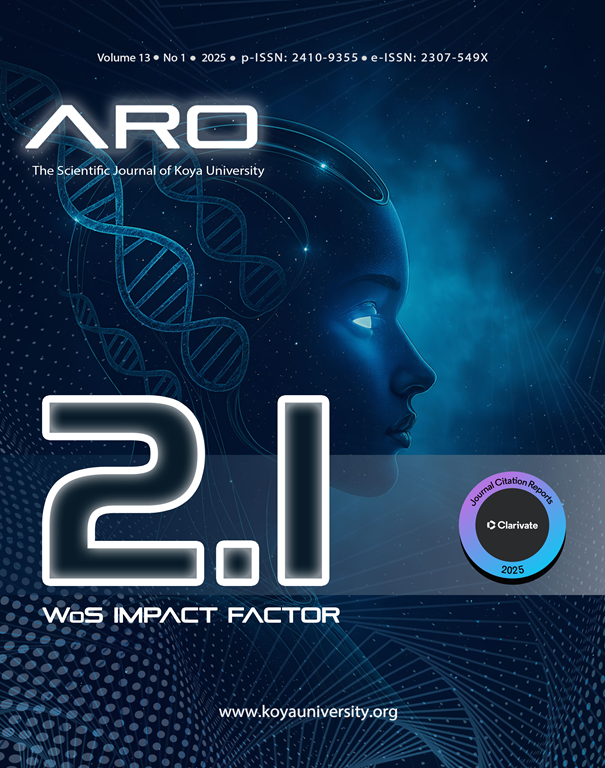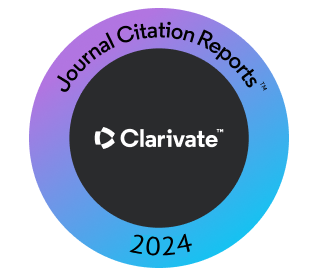Chromosome Instability and Micronucleus Frequency on the Oral Mucosa of HIV-positive Patients
DOI:
https://doi.org/10.14500/aro.12035Keywords:
Chromosome instability, DNA damage, HIV, Micronucleus, Viral loadAbstract
Extranuclear structures known as micronuclei (MN) are composed of whole or fragmented chromosomes that were not incorporated into the nucleus following cell division. The genotoxic impact of HIV infection on oral cavity cancers remains uncertain. This study sought to determine the impact of HIV infection on MN in HIV+ patients’ oral mucosa and its correlation with early cytogenetic alterations in oral carcinogenesis. A total of forty-four non-HIV patients and thirty-eight HIV+ patients were assessed in this study. Smears were collected from the oral cavity and stained with 5% methylene blue. The smears were then examined at a ×100 magnification using a standard microscope. For each participant, 100 buccal cells were counted. Further observations of the viral load (VL), lymphocytes, and granulocytes were made to determine the pattern of MN presence in HIV+ patients. Significant differences were observed between HIV+ patients and healthy controls regarding alcohol consumption (p = 0.004 < 0.05) and smoking (p = 0.041 < 0.05). The relationship between micronucleus and VL is substantial. After calculating the linear regression model, it was discovered that the VL ratio of HIV-positive patients could predict the micronucleus cells (R-Sq = 55%, p < 0.000). In conclusion, HIV VL shows increased genomic instability. These findings are relevant to understanding the mechanisms of cellular damage and developing potential strategies to mitigate carcinogenesis in HIV+ patients.
Downloads
References
Caponio, V.C.A., Silva, F.F., Popolo, F., Giugliano, S., Spizzirri, F., Lorenzo-Pouso, A.I., Padín-Iruegas, M.E., Zhurakivska, K., Muzio, L.L., and López-Pintor, R.M., 2024. State of the art of micronuclei assay in exfoliative cytology
as a clinical biomarker of genetic damage in oral carcinogenesis: A systematic review and meta-analysis. Mutation Research Reviews in Mutation Research, 794, p.108508.
Dravid, A., Morkar, D., Prasad, D., Ramapuram, J.T., Patel, K.V., Naik, K.S., Bhrusundi, M., Kulkarni, M., Hegde, S., Anuradha, S., Nageswaramma, S., Madan, S., Jayaprakash, T., and Kulkarni, V., 2022. A phase IV study on safety, tolerability, and efficacy of dolutegravir, lamivudine, and tenofovir disoproxil fumarate in treatment naive adult Indian patients living with HIV-1. Pragmatic and Observational Research, 13, pp.75-84. DOI: https://doi.org/10.2147/POR.S361907
Drews, R.M., Hernando, B., Tarabichi, M., Haase, K., Lesluyes, T., Smith, P.S., Morrill Gavarró, L., Couturier, D.L., Liu, L., Schneider, M., Brenton, J.D., Van Loo, P., Macintyre, G., and Markowetz, F., 2022. A pan-cancer compendium of chromosomal instability. Nature, 606, pp.976-983. DOI: https://doi.org/10.1038/s41586-022-04789-9
Eisinger, R.W., Dieffenbach, C.W., and Fauci, A.S., 2019. HIV viral load and transmissibility of HIV infection: Undetectable equals untransmittable. JAMA, 321, pp.451-452. DOI: https://doi.org/10.1001/jama.2018.21167
Ellwanger, J.H., Kulmann-Leal, B., Ziliotto, M., and Chies, J.A.B., 2023. HIV infection, chromosome instability, and micronucleus formation. Viruses, 15, p.155. DOI: https://doi.org/10.3390/v15010155
Faig Lima, C., Alves, M.G.O., Furtado, J.J.D., Marcelo, M., Ivan, B., and Almeida, J.D., 2017. Effect of HIV infection in the micronuclei frequency on the oral mucosa. Journal of Oral Pathology and Medicine, 46(8), pp.644-648. DOI: https://doi.org/10.1111/jop.12527
Fenech, M., and Bonassi, S., 2011. The effect of age, gender, diet and lifestyle on DNA damage measured using micronucleus frequency in human peripheral blood lymphocytes. Mutagenesis, 26, pp.43-49. DOI: https://doi.org/10.1093/mutage/geq050
Gutierrez-Sevilla, J.E., Cardenas-Bedoya, J., Escoto-Delgadillo, M., Zúniga-Gonzalez, G.M., P ́erez-Ríos, S.M., Gomez-Meda, B.C., Gonzalez-Enríquez, G.V., Figarola-Centurion, I., Chavarría-Avila, E., and Torres-Mendoza, B.M., 2021. Genomic instability in people living with HIV’. Mutation Research Genetic Toxicology and Environmental Mutagenesis, 865, p.503336. DOI: https://doi.org/10.1016/j.mrgentox.2021.503336
Haworth, K.G., Schefter, L.E., Norgaard, Z.K., Ironside, C., Adair, J.E., and Kiem, H.P., 2018. HIV infection results in clonal expansions containing integrations within pathogenesis-related biological pathways. JCI Insight, 3(13), p.e99127. DOI: https://doi.org/10.1172/jci.insight.99127
Hernández-Ramírez, R.U., Shiels, M.S., Dubrow, R., and Engels, E.A., 2017. Cancer risk in HIV-infected people in the USA from 1996 to 2012: Apopulation-based, registry-linkage study. The Lancet HIV, 4(11), pp.e495-e504. DOI: https://doi.org/10.1016/S2352-3018(17)30125-X
Ivanov, A.V., Valuev-Elliston, V.T., Ivanova, O.N., Kochetkov, S.N., Starodubova, E.S., Bartosch, B., and Isaguliants, M.G., 2016. Oxidative stress during HIV infection: Mechanisms and consequences. Oxidative Medicine and Cellular Longevity, 2016, p.8910396. DOI: https://doi.org/10.1155/2016/8910396
Jung, Y.S., and Yoon, S.J., 2022. Burden of cancer due to cigarette smoking and alcohol consumption in Korea. International Journal of Environmental Research and Public Health, 19(6), p.3493. DOI: https://doi.org/10.3390/ijerph19063493
Lima, C.F., Alves, M.G.O., Furtado, J.J.D., Marcucci, M., Balducci, I., and Almeida, J.D., 2017. Effect of HIV infection in the micronuclei frequency on the oral mucosa. Journal of Oral Pathology and Medicine, 46(7), pp.644-648. DOI: https://doi.org/10.1111/jop.12527
Luzhna, L., Kathiria, P., and Kovalchuk, O., 2013. Micronuclei in genotoxicity assessment: From genetics to epigenetics and beyond. Frontiers in Genetics, 4, p.131. DOI: https://doi.org/10.3389/fgene.2013.00131
Mohammed, A.M., Hussen, D.F., Rashad, H., and Hasheesh, A., 2020. The micronuclei scoring as a biomarker for early detection of genotoxic effect of cigarette smoking. Asian Pacific Journal of Cancer Prevention, 21(1), pp.87-92. DOI: https://doi.org/10.31557/APJCP.2020.21.1.87
Nacher, M., Huber, F., Adriouch, L., Djossou, F., Adenis, A., and Couppié, P., 2018. Temporal trend of the proportion of patients presenting with advanced HIV in French Guiana: Stuck on the asymptote? BMC Research Notes, 11(1), p.831. DOI: https://doi.org/10.1186/s13104-018-3944-y
Poetsch, A.R., 2020. The genomics of oxidative DNA damage, repair, and resulting mutagenesis. Computational and Structural Biotechnology Journal, 18, pp.207-219. DOI: https://doi.org/10.1016/j.csbj.2019.12.013
Pradeep, M.R., Guruprasad, Y., Jose, M., Saxena, K., Deepa, K., and Prabhu, V., 2014. omparative study of genotoxicity in different tobacco related habits using micronucleus assay in exfoliated buccal epithelial cells. Journal of Clinical and Diagnostic Research, 8(5), p.ZC21-ZC24.
Proulx, J., Ghaly, M., Park, I., and Borgmann, K., 2022. HIV-1-mediated acceleration of oncovirus-related non-AIDS-defining cancers. Biomedicines, 10(4), p.768. DOI: https://doi.org/10.3390/biomedicines10040768
Silverberg, M.J., Lau, B., Achenbach, C.J., Jing, Y., Althoff, K.N., D’Souza, G., Engels, E.A., Hessol, N.A., Brooks, J.T., Burchell, A.N., Gill, M.J., Goedert,J.J., Hogg, R., Horberg, M.A.,... & Dubrow, R., 2015. Cumulative incidence of cancer among persons with HIV in North America: A cohort study. Annals of Internal Medicine, 163(7), pp.507-518. DOI: https://doi.org/10.7326/M14-2768
Valverde, M., and Rojas, E., 2009. Environmental and occupational biomonitoring using the Comet assay. Mutation Research, 681, pp.93-109. DOI: https://doi.org/10.1016/j.mrrev.2008.11.001
Veenhuis, R.T., Abreu, C.M., Costa, P.A.G., Ferreira, E.A., Ratliff, J., Pohlenz, L., Shirk, E.N., Rubin, L.H., Blankson, J.N., Gama, L., and Clements, J.E., 2023.
Monocyte-derived macrophages contain persistent latent HIV reservoirs. Nature Microbiology, 8, pp.833-844. DOI: https://doi.org/10.1038/s41564-023-01349-3
Vijayan, K.K.V., Karthigeyan, K.P., Tripathi, S.P., and Hanna, L.E., 2017. Pathophysiology of CD4+ T-cell depletion in HIV-1 and HIV-2 infections. Frontiers in Immunology, 8, p.580. DOI: https://doi.org/10.3389/fimmu.2017.00580
Wang, C.C., Silverberg, M.J., and Abrams, D.I., 2014. Non-AIDS-defining malignancies in the HIV-infected population. Current Infectious Disease Reports, 16(6), pp.406. DOI: https://doi.org/10.1007/s11908-014-0406-0
World Health Organization., 2024. HIV and AIDS. Avialable from: https://www.who.int/news-room/fact-sheets/detail/hiv-aids [Last accessed on 2024 Oct 09].
Zizza, A., Grima, P., Andreassi, M.G., Tumolo, M.R., Borghini, A., Donno, D.E., Negro, P., and Guido, M., 2019. HIV infection and frequency of micronucleus in human peripheral blood cells. Journal of Preventive Medicine and Hygiene, 60(3), pp.E191-E196.
Downloads
Published
How to Cite
Issue
Section
License
Copyright (c) 2025 saifadin k. Mustafa

This work is licensed under a Creative Commons Attribution-NonCommercial-ShareAlike 4.0 International License.
Authors who choose to publish their work with Aro agree to the following terms:
-
Authors retain the copyright to their work and grant the journal the right of first publication. The work is simultaneously licensed under a Creative Commons Attribution License [CC BY-NC-SA 4.0]. This license allows others to share the work with an acknowledgement of the work's authorship and initial publication in this journal.
-
Authors have the freedom to enter into separate agreements for the non-exclusive distribution of the journal's published version of the work. This includes options such as posting it to an institutional repository or publishing it in a book, as long as proper acknowledgement is given to its initial publication in this journal.
-
Authors are encouraged to share and post their work online, including in institutional repositories or on their personal websites, both prior to and during the submission process. This practice can lead to productive exchanges and increase the visibility and citation of the published work.
By agreeing to these terms, authors acknowledge the importance of open access and the benefits it brings to the scholarly community.
Accepted 2025-05-11
Published 2025-05-25
















 ARO Journal is a scientific, peer-reviewed, periodical, and diamond OAJ that has no APC or ASC.
ARO Journal is a scientific, peer-reviewed, periodical, and diamond OAJ that has no APC or ASC.